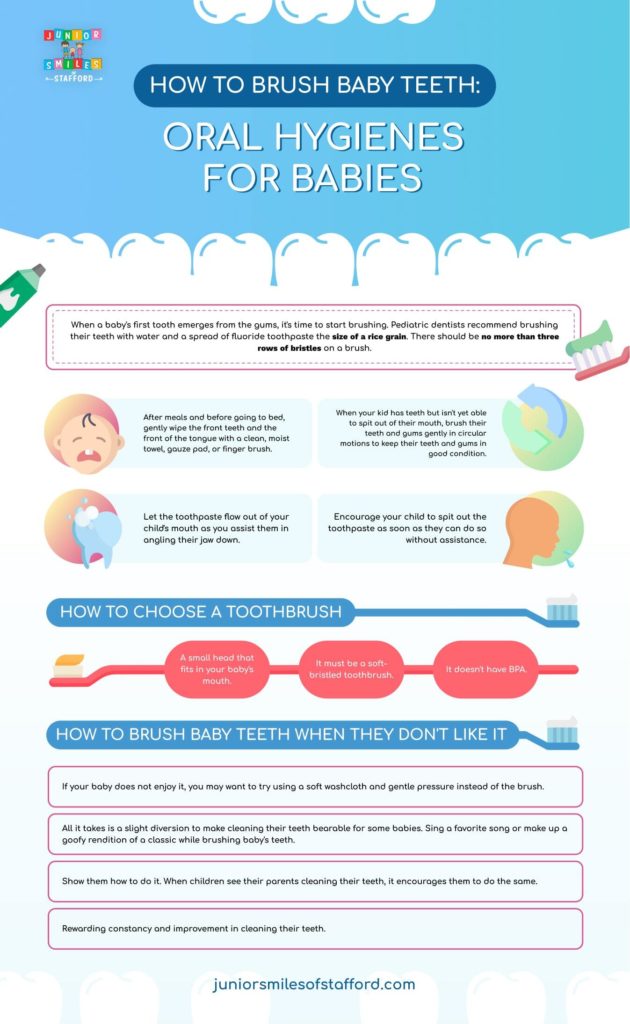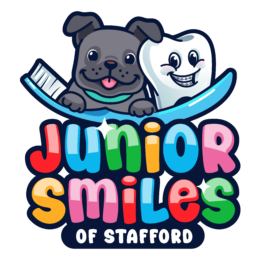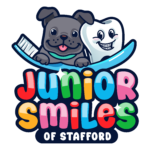How to Brush Baby Teeth: Oral Hygiene for Babies


Maintaining oral health from infancy is crucial for preventing issues such as decayed baby teeth and setting the foundation for future teeth, including permanent adult teeth. As a new parent, it’s important to embrace this aspect of healthy habits early on. Brushing your baby’s teeth might seem simple, but it requires careful attention and the right tools.
This guide offers practical advice for creating a positive and effective toothbrushing routine, from selecting the perfect soft-bristled baby toothbrush to mastering a gentle brushing technique that keeps little mouths healthy. Learn how to make brushing enjoyable and establish healthy habits that will protect your baby’s future teeth and set the stage for a lifetime of bright smiles.
Importance of Baby Oral Hygiene
Maintaining oral health from infancy is crucial for preventing issues such as decayed baby teeth and setting the foundation for future teeth, including permanent adult teeth. As a new parent, it’s important to embrace this aspect of healthy habits early on. Brushing your baby’s teeth might seem simple, but it requires careful attention and the right tools.
The significance of oral hygiene for babies cannot be overstated. Baby teeth, also known as primary teeth, play a crucial role in a child’s development. They help in proper chewing, speech development, and also hold space for the permanent teeth. Neglecting the care of baby teeth can lead to issues such as bottle tooth decay, which can cause pain and discomfort for the child. Additionally, it can also lead to misalignment of permanent teeth.
Preventing decayed baby teeth and future dental issues starts with establishing good oral hygiene habits early on. This not only sets the stage for a lifetime of healthy teeth and gums but also helps your child become accustomed to the daily routine of oral care.
When to Start Brushing Baby Teeth
Introducing oral hygiene early on is essential for the overall well-being of your baby. Even before the first tooth appears, it’s important to clean your baby’s gums. You can do this by gently wiping the gums with a clean, damp washcloth or gauze pad after feedings.
Once the first tooth appears, usually around 6 months of age, it’s time to start brushing. However, every child is different, and some may start teething earlier or later. Signs that your baby is ready for toothbrushing include the appearance of the first tooth, increased drooling, and the baby’s tendency to chew on objects.
Choosing the Right Toothbrush and Toothpaste
Selecting a suitable toothbrush for babies is crucial. Look for a toothbrush with soft bristles and a small head that is specifically designed for infants. The size and gentleness of the brush will help you to clean your baby’s teeth and gums effectively without causing any discomfort.
When it comes to toothpaste, it’s important to choose a safe option for your baby’s oral hygiene. The American Academy of Pediatrics and the American Dental Association recommend using a smear of fluoride toothpaste about the size of a grain of rice for children under 3 years old. For children 3-6 years old, a pea-sized amount of fluoride toothpaste is recommended.
How to Brush Baby Teeth Properly
Proper brushing techniques for babies are essential to ensure effective cleaning without causing any harm. Use a small amount of fluoride toothpaste on the brush and gently brush the teeth and gums in circular motions. Be gentle and make sure to cover all surfaces of the teeth. As your baby grows, you can teach them how to spit out the toothpaste but continue to supervise their brushing until they are able to do it effectively on their own.
Making toothbrushing a positive experience for your baby is important for establishing good oral hygiene habits. You can make it fun by singing a song, making funny faces, or letting your baby hold the toothbrush and “brush” their own teeth.
Additional Tips for Baby Oral Care
In addition to brushing, there are other oral care practices for babies that can help maintain good oral hygiene. This includes avoiding putting your baby to bed with a bottle, cleaning pacifiers with water rather than your own mouth, and encouraging healthy eating habits.
As for the first dental visit, the American Academy of Pediatric Dentistry recommends scheduling it within six months of the eruption of the first tooth, or by your baby’s first birthday. This early visit allows the pediatric dentist to monitor the development of your baby’s teeth and provide guidance on oral care practices.
In conclusion, taking care of your baby’s oral health is an important aspect of parenting. By starting early, choosing the right tools, and practicing proper techniques, you can set the stage for a lifetime of healthy teeth and gums for your child. Remember, good oral hygiene habits developed in infancy can have a lasting impact on your child’s overall health.
Frequently Asked Questions
Should I Brush My Baby’s Gums?
Yes, brushing your baby’s gums before their teeth come in can prevent the buildup of bacteria and soothe teething discomfort. Use a soft, damp cloth or a soft rubber finger brush to clean the gums after feedings, which can help ease the transition to an actual toothbrush when the teeth begin to appear.
What Happens if You Don’t Brush Baby’s Teeth?
Skipping brushing can lead to plaque buildup, resulting in tooth decay and potential gum disease. Decayed baby teeth can cause pain, affect eating and speaking, and may impact the health and alignment of future permanent teeth, emphasizing the importance of regular brushing from the start.
Do Babies Need Toothpaste?
Yes, once the first tooth emerges, a smear of fluoride toothpaste the size of a grain of rice is recommended to help prevent decay and strengthen enamel. It’s important to use a baby-specific fluoride toothpaste in minimal amounts to avoid dental fluorosis while still reaping the protective benefits of fluoride.
Contact Junior Smiles of Stafford Today for Expert Baby Oral Care Guidance
At Junior Smiles of Stafford, we understand the importance of early dental care and are dedicated to supporting parents and their little ones on this journey. Whether you need advice on the best toothbrushing techniques, selecting the right toothpaste, or scheduling your baby’s first dental check-up, our team is here to help. Don’t hesitate to reach out for expert guidance and support in fostering your baby’s oral health.
For more information or to schedule an appointment, contact us today. We’re committed to ensuring your baby’s smile remains as joyful and healthy as their laughter.
s baby teeth poking through the gums, your heart melts. But do you know the best oral care practices for maintaining a child’s dental health in the years to come? This blog will be your guide throughout your baby’s dental care routine!
How To Brush Baby Teeth
Before you have any teeth, brushing your baby’s gums may be as simple as using a washcloth and water or as complex as using a finger brush and water. It’s essential to clean the gums thoroughly and under your lips, so use a soft cloth.
When your kid has teeth but isn’t yet able to spit out of their mouth, brush their teeth and gums gently in circular motions to keep their teeth and gums in good condition. Using a pea-sized amount of toothpaste (the rice grain size) is acceptable for youngsters under 3.
Let the toothpaste flow out of your child’s mouth as you assist them in angling their jaw down. Then, encourage your child to spit out the toothpaste as soon as they can do so without assistance.
According to the American Dental Association, fluoride toothpaste is safe and beneficial even for youngsters. It’s critical, though, to follow the dosage instructions strictly. Fluoride should have no detrimental effects if it is ingested at this level. If you eat more than this, you may get a stomach ache. However, fluoride can harm tooth enamel over time; therefore, it’s best to wait before introducing it until the first tooth has erupted above the gum line. Until then, all you need is water and a washcloth or finger brush.
How To Choose a Toothbrush
They may not be ready for a traditional toothbrush when their teeth start in. This is when you can get creative with your brushing. You can use a finger brush or cleaning wipes to help. You can also use a clean, damp washcloth to get rid of the dirt. In either case, the best infant toothbrush should have these things:
- A small head that fits in your baby’s mouth.
- It must be a soft-bristled toothbrush.
- It doesn’t have BPA.
It’s also good for babies who don’t have any teeth yet or are about to get their first set of teeth. Silicone finger brushes are also good for these babies. There are usually silicone brushes with soft and thick bristles made of silicone. The handles are generally also made of silicone. Silicone brushes are usually more gentle and make good teething toys, but they can also be rough. However, as more teeth come in, silicone brushes aren’t as good at preventing plaque as nylon-bristled toothbrushes. Keep this in mind as your child gets more teeth. This is important to remember.
When To Start Brushing Baby Teeth
When a baby’s first tooth emerges from the gums, it’s time to start brushing. After meals and before going to bed, gently wipe the front teeth and the front of the tongue with a clean, moist towel, gauze pad, or finger brush.
Pediatric dentists recommend brushing your teeth with water and a spread of fluoride toothpaste the size of a rice grain. There should be no more than three rows of bristles on a brush (a pediatric dentist or your pharmacist can help you find the finger brushes and a proper baby toothbrush).
Throw away any toothbrushes that have worn down to the point of becoming unusable (or that are more than two to four months old because mouth bacteria can begin to build up).
How To Brush Baby Teeth When They Don’t Like It
They may be particularly reluctant to get their teeth cleaned due to teething discomfort. However, if brushing your teeth becomes a daily routine, here are some ideas to keep their mouth clean:
- If your baby does not enjoy it, you may want to try using a soft washcloth and gentle pressure instead of the brush.
- All it takes is a slight diversion to make cleaning their teeth bearable for some babies. Sing a favorite song or make up a goofy rendition of a classic while brushing baby’s teeth. Create a particular tooth brushing song. You may get a tiny-toothed smile in return.
- Show them how to do it. When children see their parents cleaning their teeth, it encourages them to do the same. “It’s time for you, Mom! You’ve had your turn!” Allow them to express themselves: The toothbrush or finger brush is likely to pique your baby’s interest. Allow them to handle the brush and inspect it at their speed to pique her interest. They may even put the brush in her mouth when they get older without any prompting.
Rewarding constancy and improvement in cleaning their teeth might motivate a little additional effort and a better mood at the end of the day! These can be modified in any way that makes the most sense for you and your child.
Read more: Best Toothbrush for Kids and What Age To Start Using A Real Toothbrush

